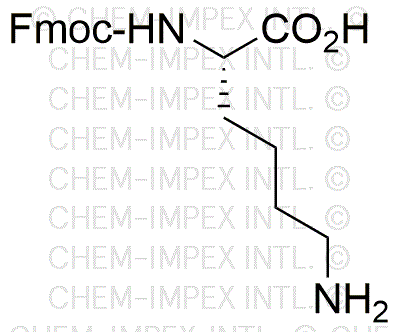Fmoc-L-lysine is widely utilized in research focused on:
- Peptide Synthesis: This compound serves as a key building block in the synthesis of peptides, allowing for the introduction of lysine residues. Its protective Fmoc group simplifies the process of sequential addition of amino acids.
- Drug Development: In pharmaceutical research, Fmoc-L-lysine is used to create peptide-based drugs, enhancing the stability and bioavailability of therapeutic agents.
- Bioconjugation: The compound is valuable in bioconjugation techniques, where it can be linked to various biomolecules, facilitating the development of targeted drug delivery systems.
- Protein Engineering: Researchers utilize Fmoc-L-lysine in the design of modified proteins, which can improve their functionality and stability for various applications in biotechnology.
- Diagnostics: In the field of diagnostics, Fmoc-L-lysine is employed in the creation of peptide-based assays, which can enhance the sensitivity and specificity of disease detection methods.
General Information
Properties
Safety and Regulations
Applications
Fmoc-L-lysine is widely utilized in research focused on:
- Peptide Synthesis: This compound serves as a key building block in the synthesis of peptides, allowing for the introduction of lysine residues. Its protective Fmoc group simplifies the process of sequential addition of amino acids.
- Drug Development: In pharmaceutical research, Fmoc-L-lysine is used to create peptide-based drugs, enhancing the stability and bioavailability of therapeutic agents.
- Bioconjugation: The compound is valuable in bioconjugation techniques, where it can be linked to various biomolecules, facilitating the development of targeted drug delivery systems.
- Protein Engineering: Researchers utilize Fmoc-L-lysine in the design of modified proteins, which can improve their functionality and stability for various applications in biotechnology.
- Diagnostics: In the field of diagnostics, Fmoc-L-lysine is employed in the creation of peptide-based assays, which can enhance the sensitivity and specificity of disease detection methods.
Documents
Safety Data Sheets (SDS)
The SDS provides comprehensive safety information on handling, storage, and disposal of the product.
Product Specification (PS)
The PS provides a comprehensive breakdown of the product’s properties, including chemical composition, physical state, purity, and storage requirements. It also details acceptable quality ranges and the product's intended applications.
Certificates of Analysis (COA)
Search for Certificates of Analysis (COA) by entering the products Lot Number. Lot and Batch Numbers can be found on a product’s label following the words ‘Lot’ or ‘Batch’.
*Catalog Number
*Lot Number
Certificates Of Origin (COO)
This COO confirms the country where the product was manufactured, and also details the materials and components used in it and whether it is derived from natural, synthetic, or other specific sources. This certificate may be required for customs, trade, and regulatory compliance.
*Catalog Number
*Lot Number
Safety Data Sheets (SDS)
The SDS provides comprehensive safety information on handling, storage, and disposal of the product.
DownloadProduct Specification (PS)
The PS provides a comprehensive breakdown of the product’s properties, including chemical composition, physical state, purity, and storage requirements. It also details acceptable quality ranges and the product's intended applications.
DownloadCertificates of Analysis (COA)
Search for Certificates of Analysis (COA) by entering the products Lot Number. Lot and Batch Numbers can be found on a product’s label following the words ‘Lot’ or ‘Batch’.
*Catalog Number
*Lot Number
Certificates Of Origin (COO)
This COO confirms the country where the product was manufactured, and also details the materials and components used in it and whether it is derived from natural, synthetic, or other specific sources. This certificate may be required for customs, trade, and regulatory compliance.


